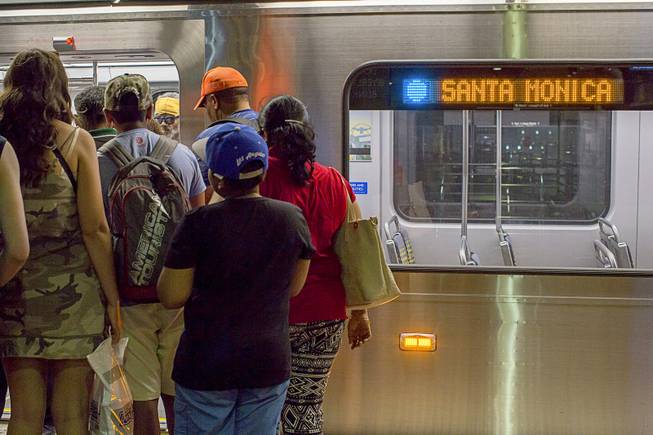
Monica Almeida / The New York Times
Passengers at the Expo/7th St. Metro Center Station in Los Angeles, July 7, 2016. With the excitement it generated, the Los Angles Metro Expo line, more than others, seemed to portend a potentially game-changing moment for public transportation in the area, but although the entire Expo Line is steadily gaining riders car culture is hardly disappearing.
Monday, July 18, 2016 | 2 a.m.
LOS ANGELES — When the so-called subway to the sea began running between downtown Los Angeles and Santa Monica this year, it was greeted with a kind of revelry and attention usually reserved for only the hottest celebrity-studded film screenings.
Now, nearly two months later, the sheen has mostly worn off, replaced by workaday concerns of daily commuters, who most often have their heads deeply bowed to their phones as the train lurches along Exposition Boulevard.
It is neither a subway — the train is in fact elevated more often than it is underground — nor does it go all the way to sea. But as a passenger travels west from downtown to Santa Monica, a ride along the Expo Line offers a small portrait of this sprawling city.
There are the riots of bougainvillea, in violet, magenta and white, reaching over the walls along the street. The crows give way to sea gulls, and the endless array of auto body shops are replaced with an endless array of yoga studios. (Pressed juices for $12 can easily be found within walking distance of either terminal.)
The subway to the sea is a continuation of the Expo Line, which originally ran between downtown Los Angeles and Culver City. Though hailed as a potential traffic reliever for the millions of people who commute from the city’s wealthy neighborhoods on the Westside to downtown, the train is much more crowded coming from the east, home to the city’s poorer residents, many of whom lack cars. They commute to jobs on the Westside as restaurant workers and baby sitters, sitting next to hipsters and retirees who have chosen to move downtown and take the train to the water.
Sharon and Michael Stein traded their suburban comforts for downtown this spring and take the train each Wednesday from downtown to the Santa Monica Farmer’s Market. Sharon Stein, 56, uses the train map to find new places to shop or to get her hair cut.
Magdalena Placencia takes the train every day from La Brea to 17th Street in Santa Monica, where she works as a nanny. “It’s much faster and much cleaner than the bus,” she said. “Now I can leave 30 minutes later and get to work 30 minutes earlier.” She added, “I watch the city pass by without feeling like I will throw up, like I used to on the bus.”
With the excitement it generated, this train, more than others, seemed to portend a potentially game-changing moment for public transportation here. Some hope that it will finally persuade the well-to-do here to start taking public transportation in substantial numbers. But although the entire Expo Line is steadily gaining riders, transit authority officials say, the car culture is hardly disappearing.
When the train began running at the end of May, there was considerable worry that the parking lots were too meager to serve the cars bringing the would-be passengers to the stations scattered across the Westside. But these days the lots are only partly full. The teeming crowds have yet to materialize to travel east.
On its path to the ocean, the train first rises up from underground alongside the Staples Center, downtown’s entertainment and sports hub. It hums past the University of Southern California and the nearby rose garden, past a mosque and stained-glass churches, and past turquoise graffiti shouting, “It’s all love,” in letters taller than many men. On the way, the small bungalows in the east turn to boxy modern renovations in the west, where it is possible to smell the ocean even if it cannot quite be seen.
There is refined art, too. A stop into Santa Monica reveals galleries just steps from the train. Even if you do not get off to stop in, it brings some degree of comforting joy, just knowing they are there.
Some come on two wheels to take the train, but they are quietly frustrated that there are not dedicated spots for bikes aboard. Other complaints are as particular as people — one worries about the bacteria in the carpetlike fabric covering the seats, another laments that there are no synchronized lights to help the train beat the street traffic running alongside it. For a security guard who works the graveyard shift in Burbank, the train is merely the final leg of a three-vehicle, two-hour commute to her home in Mid-City near La Brea Avenue.
But there are signs of deep appreciation, too. A pair of friends coming from the Veterans Affairs hospital to a midday, midweek Dodger baseball game were grateful that they were spared a more crowded ride on the bus. A film editor whose office decided months ago not to pay for parking was happy for an alternative to his car. Riding his bike to the train, he said, was infinitely better than cruising the nearby streets for a place to park.
Michael Stein, 57, who gave up the suburbs for downtown, grew up here but aspires to get rid of his two cars. “I would love to see more of my friends convinced that they could ride this to get around,” he said.

Join the Discussion:
Check this out for a full explanation of our conversion to the LiveFyre commenting system and instructions on how to sign up for an account.
Full comments policy